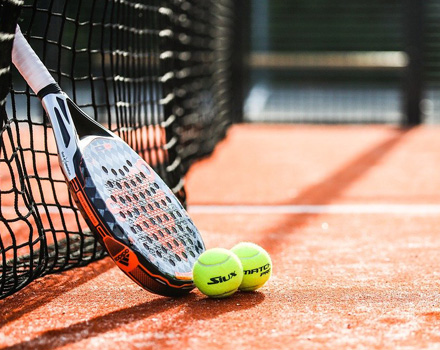Padel
The fastest growing sport in the world! Padel (sometimes referred to as Paddle Tennis) is a racket sport played in an enclosed court, where participants can play off the surrounding walls following a single ball bounce off the ground. The court is around one third the size of a tennis court (20m x 10m) with no doors on either side, which allows players to hit and retrieve the ball from outside the court. Padel is mainly played in doubles, however can also be played in singles, albeit requires a lot more ground to cover in that case (great for those looking to lose weight!). Scoring is identical to tennis; noting that the service is played underhand (under waist) following a ball bounce off the ground.
History Glimpse of Padel
In 1962, a Mexican billionaire contractor by the name of Enrique Corcuera modified his home squash court in Acapulco, Mexico by adding elements of platform tennis. His inspiration for the sport stemmed from other racket sports including tennis, squash and badminton, which he named “Paddle Curcuera” or “Paddle Tennis” (now known as Padel). A few years later, he invited his friend, Alfonso de Hohenlohe, from Spain, who was intrigued by his friend’s sport and decided to spread his fascination to his home country. In 1970, Hohenlohe returned to Marbella, Spain, and went on to form the first padel courts there. Thereafter, the sport underwent a number of iterations, growing in popularity and capturing the attention of renowned tennis players including the legendary former world number one, Manuel Santana. The rest is history!
1990s – First International Tournament
In 1991, the first international championship tournament, the World Padel Championship, was organized by the International Padel Federation in Madrid. At that stage, countries that had developed the sport extensively took part, including Spain, Argentina, the UK and France.
2005 – The Padel Pro Tour
In 2005, the Padel Pro Tour was established as the first international professional championship tour. Its goal was to cement the status of the sport by developing a tournament calendar as well as male and female player rankings.
2013 – The World Padel Tour
In 2013, the World Padel Tour was established to replace the Padel Pro Tour, and act as the elite global authority for formulating Padel rankings through a series of 15 to 20 tournaments, ending with a Final Master Series at the end of each year.
Padel Today
Nowadays, there are approximately 20 million practicing players and over 4,000 padel clubs worldwide. Out of those, 3,500 are in Spain with rest spread across the world, mainly Southern America and Europe, noting a strong surge in the MENA region in recent years; deeming it more likely to witness the sport in the 2024 Olympics.
Padel Rackets
•Padel rackets do NOT have strings. These unique rackets are solid and perforated, the core of which are made out of ethylene-vinyl acetate, which is covered by either plastic or a more expensive carbon.
•The average weight of rackets range between 340g to 370g
•Rackets should be no longer than 45.5cm in total. The grips should not exceed 20cm in length, while the head should not be more than 26cm wide and not exceed 38mm in thickness.
The Court
•Padel courts are 20m long by 10m wide, with 4 surrounding glass walls and fences that extend up to 4 meters in height.
•A 10m long net divides the court in two that measures 88cm in height at the center.
•Courts can be indoors or outdoors and sometimes shading options are used.





